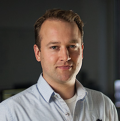 In this thesis a complex oxide is central. These type of materials are interesting as they exhibit spectacular phenomena including: colossal magnetoresistance, high transition temperature superconductivity, ferromagnetism and ferroelectricity. This PhD work describes LaAlO3/SrTiO3 interfaces: its synthesis, magnetic effects, unconventional oscillations, interfacial structure and the interplay between spatially separated conducting sheets.
In this thesis a complex oxide is central. These type of materials are interesting as they exhibit spectacular phenomena including: colossal magnetoresistance, high transition temperature superconductivity, ferromagnetism and ferroelectricity. This PhD work describes LaAlO3/SrTiO3 interfaces: its synthesis, magnetic effects, unconventional oscillations, interfacial structure and the interplay between spatially separated conducting sheets.
‘The substrate surfaces can be controlled ever better,’ says Jeroen Huijben. ‘Epitaxial deposition allows the synthesis of abrupt interfaces, changing from one material to another over the distance of only one single unit cell.’
Specifically in this thesis research, the interface between LaAlO3 and SrTiO3 is studied. ‘We aimed at a better understanding of the behaviour, and possible exploitation, of the two-dimensional electron gas present at this interface. This gas showed high electron mobility and intriguing magnetoresistance oscillations.’
A successful synthesis method for epitaxial LaAlO3/SrTiO3 interfaces was described with examples for single interfaces, heterostructures and superlattices. Also, the existence of induced magnetism and transport properties on LaAlO3/SrTiO3 interfaces has been studied, down to 50 mK and in magnetic fields up to 30 T. ‘It was theoretically predicted that magnetism can be induced at the interface between otherwise nonmagnetic SrTiO3 and LaAlO3,’ Jeroen says.
Further, heterostructures of LaAlO3/SrTiO3 bilayers on (001)-oriented SrTiO3 substrates were studied.
‘The coupling between sub-nanometer spaced conducting interfaces allowed us to do so,’ Jeroen writes. ‘The characterization was achieved by scanning tunnelling microscopy and spectroscopy experiments.’
Nijmegen, Grenoble and Karlsruhe
Jeroen: ‘It was a great privilege to work with highly specialized equipment facilities and experts supervising the apparatus. The low temperature/high magnetic field measurements were performed within High Field Magnet Laboratory (HFML) in Nijmegen. Together with the experts we performed joint experiments, making the best of the lab time available. Without their help this would have been impossible.’
‘I benefitted from the long-term collaboration between Mesa+ and HFML. Also very special was the collaboration with the European Synchroton Radiation Facility (ESRF) in Grenoble and Synchrotron Radiation Source in Karlsruhe. Within Mesa+ itself, several techniques such as scanning tunnelling spectroscopy were employed.’
Major step
Jeroen recalls the fabrication of crystal interfaces in which the materials were stacked at sub-nanometer level with reduced oxygen vacancy levels, as a highlight.
‘In those days this was a major step within this new and promising research field,’ he says. ‘The experiments were performed some time ago already, as I started spin-off company Nymus3D and subsequently started working at DEMCON Advanced Mechatronics before actually finishing my thesis work.’
‘Now, some ten years later, I still follow the actual developments within the thesis field of research. Many phenomena and experimental outcomes have now been confirmed, using more advanced and direct experiments. Also, novel material combinations are now being investigated. Our pioneering work resulted in a toolbox for the next generation of researchers. It is great to see these developments still happening today.’
Commercial setting
Jeroen: ‘In many respects the PhD project has brought me a lot. Having time to investigate a topic thoroughly, is a unique life experience in itself. I enjoyed the collaboration and open atmosphere with all colleagues and with my promotors. The Strategic Research Orientation Group, led by Professor Wilfred van der Wiel, I valued greatly. Nice collaborations and new research ideas originated from there.’
‘During the PhD, within Nymus3D, I started to work on visualisations regarding academic research. I was fascinated by the commercial setting and the short term dynamics of life within industry. I really enjoy the direct customer contact moments, working at set goals but also being able to plan towards longer term results. Within DEMCON I now work as project manager on various medical topics and devices. I believe we have a nice design and product innovation philosophy and strategy, which I advocate strongly. I guess I found my way at R&D within industry. It suits me very well.’
